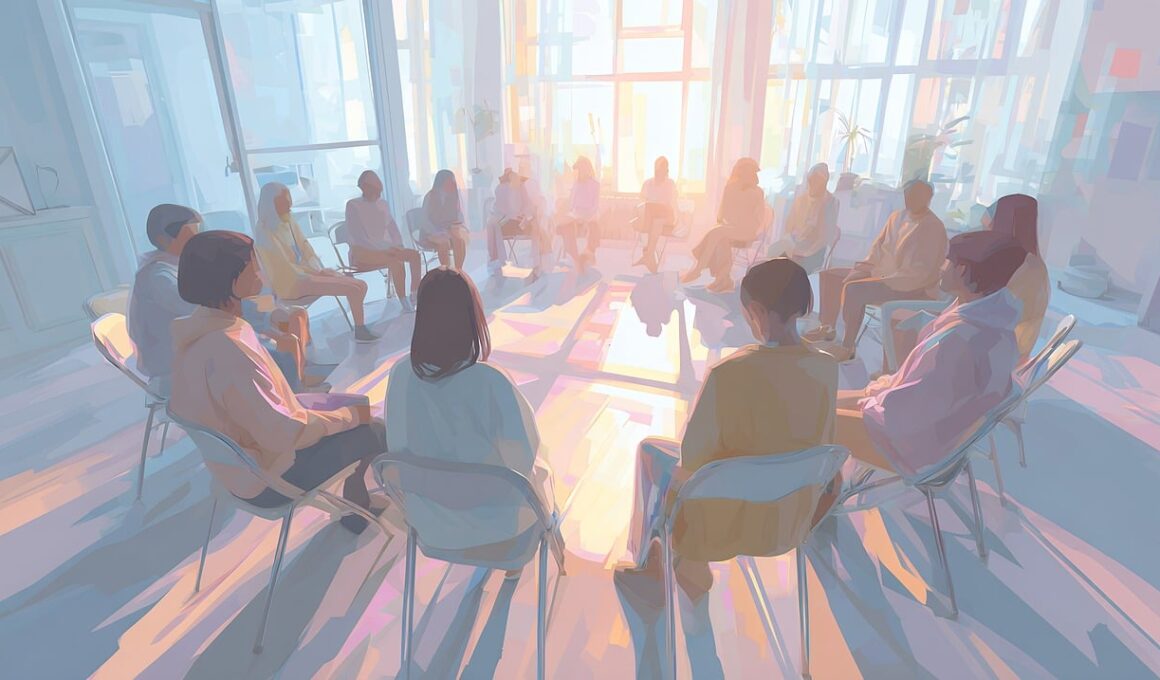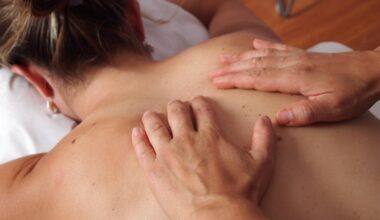Fitness Communities as Support Networks for PTSD Survivors
Post-Traumatic Stress Disorder (PTSD) can lead individuals to feel isolated and alone, making recovery seem daunting. Joining fitness communities can transform this experience. These groups provide encouraging environments designed to foster connection and create support networks. Engaging in regular physical activity can significantly alleviate PTSD symptoms, notably anxiety and depression. Group activities such as yoga or martial arts not only promote physical fitness but also enhance mental well-being. Meeting like-minded individuals who understand the unique challenges of PTSD can foster camaraderie. Additionally, shared experiences in workouts can create trust, enabling individuals to open up about their feelings and experiences. Members often share tips for coping and offer motivation to push through tough moments. In these communities, friendships can flourish, providing a solid support system throughout the healing journey. The atmosphere of collective growth encourages resilience, facilitating a more robust approach to mental health recovery. Overall, fitness communities are invaluable resources for PTSD survivors looking to regain control over their lives while rebuilding social connections and establishing a healthier lifestyle.
The Benefits of Physical Activity for Mental Health
Physical activity offers numerous benefits for mental health, particularly for those grappling with PTSD. Engaging in exercise can release endorphins, which are hormones that promote happiness and decrease pain perception. Regular engagement in fitness helps reduce stress by lowering cortisol levels, leading to a calmer state of mind. Alongside the physical benefits, participating in a structured workout regimen can enhance self-esteem and instill a sense of achievement. Victories, no matter how small, can motivate individuals to continue their journey toward recovery. Activities such as running, swimming, cycling, and even hiking can serve as therapeutic outlets. Immersion in nature during outdoor activities like hiking has been shown to bolster mood and overall well-being. The rhythmic nature of many exercises often provides a meditative effect, allowing participants to focus less on their trauma and more on their present surroundings. Furthermore, the social aspect of fitness groups can cultivate lasting relationships that extend beyond workouts. In these communities, individuals find common ground among their struggles while celebrating each other’s triumphs, fostering resilience and hope during the recovery process.
Connecting with peers who share similar experiences can greatly enhance recovery for PTSD survivors. In fitness classes or running groups, individuals forge bonds that often translate into lasting friendships. These connections provide a sense of belonging that can diminish feelings of isolation. Sharing personal experiences can foster empathy, validating feelings and promoting healing. When participating in group exercises, individuals frequently find comfort in one another’s stories. Consequently, discussions naturally emerge, creating a space for emotional expression. This open dialogue allows members to dive deeper into coping strategies, offering invaluable insights. Exercise routines often become a safe haven, a place where members know they are understood. As relationships deepen, support extends beyond the confines of a workout. Members often check in on one another, creating accountability that encourages consistent participation. This consistent engagement not only enhances fitness levels but also strengthens mental fortitude. For many, being a part of this community can serve as a catalyst for recovery. Therefore, fostering these connections is integral in combating the loneliness associated with PTSD while discovering the power of collective healing.
Types of Fitness Activities Beneficial for PTSD
Exploring various fitness activities can help PTSD survivors find methods of coping that suit their preferences. Group exercise classes, such as Zumba or spin, offer fantastic options that combine physical intensity with social interaction. These high-energy formats allow individuals to engage their bodies and minds, focusing on movement rather than past trauma. Additionally, martial arts classes can foster discipline and increase self-defense skills, contributing to feelings of empowerment. Another beneficial option is yoga, known for its emphasis on mindfulness and relaxation techniques, which can significantly help individuals manage anxiety. Tai Chi, often referred to as “meditation in motion,” encourages fluid movements and promotes tranquility. Outdoor activities, such as hiking or biking, promote not only fitness but a deeper appreciation of nature. Each of these activities contributes to rebuilding self-esteem and resilience. In fitness communities, participants often share experiences regarding these activities and can help one another explore new classes or routines. Combining physical fitness with emotional support leads to holistic healing, giving PTSD survivors a renewed approach to recovery that focuses on personal growth.
Beyond fitness, mental health awareness is increasingly vital within these communities. Raise awareness by encouraging members to participate in workshops or seminars focusing on mental health education. Offering resources on PTSD and its impact can equip individuals with tools to better understand their struggles. Many fitness groups collaborate with mental health organizations to provide valuable information. From guest speakers to guided discussions, community support extends deeper than physical activity. Members not only learn about coping mechanisms but also how to navigate mental health challenges together. Establishing a culture of understanding fosters compassion and openness among participants. Including resources like pamphlets or contact information for therapists can further enrich these spaces. Accessibility to professional help ensures that individuals receive support tailored to their needs. Workshops that address self-care and vulnerability are instrumental in breaking down stigma. Fitness communities become places for healing and learning, creating a unified front against mental health struggles. Overall, these awareness initiatives integrate seamlessly into existing fitness practices, serving as an essential complement to physical activities and enhancing the collective strength of the community.
Creating Lasting Relationships and Accountability
Forming lasting relationships within fitness communities is vital for PTSD survivors seeking support. The bonds established in these settings often lead to emotional exploration and increased accountability in workouts. Regular meetings and sessions create familiarity, allowing members to provide reassurance to each other in challenging moments. Establishing workout buddy systems can find each individual a partner to share the journey. This not only adds an element of fun but also creates motivation rooted in friendship. When one member is struggling to attend workouts, accountability partners can provide gentle nudges to encourage participation. Moreover, sharing goals and achievements strengthens these relationships. Celebrating milestones, from completing a tough workout to running a marathon, cultivates a sense of community pride. Members become invested in each other’s journeys, fostering personal growth alongside collective healing. Additionally, special events like fitness challenges or social gatherings can enhance cohesion among participants. Through these efforts, communities can become more than mere exercise groups; they evolve into support networks. In essence, the human connections within fitness communities become invaluable components of recovery, nurturing camaraderie that transcends challenging experiences.
As the journey progresses, recovery from PTSD is often a winding road full of ups and downs. A supportive fitness community can greatly mitigate the challenges faced along this path. Encouragement provided by peers fosters resilience, helping members navigate setbacks while staying motivated. Consistent engagement in fitness activities allows individuals to reconstruct their identities outside of their trauma. The shared sense of purpose drives them to keep moving forward together. Additionally, the motivation derived from working toward common goals helps instill hope in each other. Moreover, members understand the unique challenges of PTSD, fostering an empathetic environment that encourages healing. This supportive backdrop helps individuals confront their fears and embrace vulnerability without judgment. The flexibility within fitness activities allows for adapting sessions as needed, accommodating different capabilities and experiences. Alongside structured regimes, informal activities such as group walks or volunteer garden work encourage connection while promoting fitness. Overall, the role of fitness communities as support networks unlocks the potential for improved mental health outcomes, tailored not only toward personal growth but collective resilience in overcoming PTSD.
In conclusion, fitness communities arise as vital lifelines for PTSD survivors in search of support. They offer not only a platform for physical activity but also a framework for sharing emotional experiences. The dual benefits highlight the significance of engaging with peers who understand trauma and mental health challenges. Members who participate in group activities find empowerment through shared connections and collective motivation. By engaging physically, members experience clearer minds and resilient spirits, leading to a healthier lifestyle uniquely designed for recovery. The holistic approach to healing nurtured within these groups reflects the essence of camaraderie. This bond can bring individuals together, forging lasting friendships that extend beyond workouts. Furthermore, education initiatives promote mental health awareness, reinforcing the importance of connection and understanding. Ultimately, these supportive networks prove essential, offering resources, resilience, and relationship-building opportunities vital for enduring recovery. In fostering a community filled with compassion, fitness becomes less of a task and more of a shared journey. Encouraging ongoing participation can help maintain personal growth while reclaiming lives from PTSD, enabling a brighter future fueled by hope and friendship.


